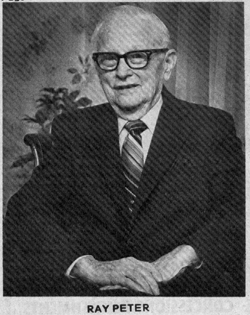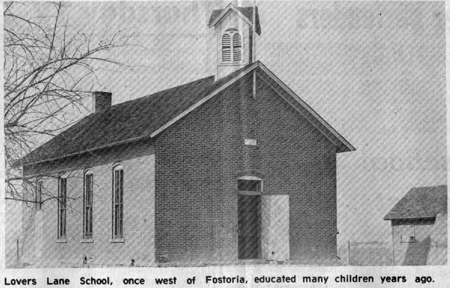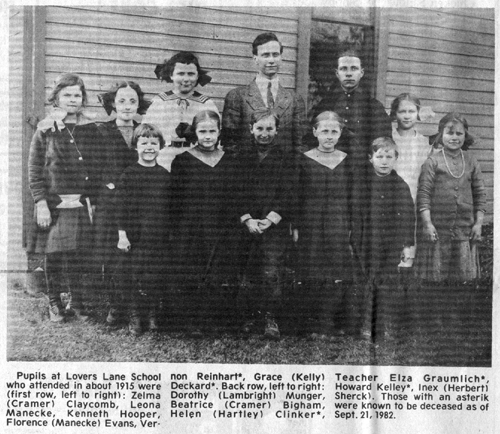June 23, 1983



Picture #1 – Ray Peter
Picture #2 – Lovers Lane School, once west of Fostoria, educated many children years ago.
Picture #3 – Pupils at Lovers Lane School who attended in about 1915 were (first row, left to right): Zelma (Cramer) Claycomb, Leona Manecke, Kenneth Hooper, Florence (Manecke) Evans, Vernon Reinhart*, Grace (Kelly) Deckard*. Back row, left to right: Dorothy (Lambright) Munger, Beatrice (Cramer) Bigham, Helen (Hartley) Clinker*, Teacher Elza Garu Graumlich*, Howard Kelley*, Inex (Herbert) Sherck. Those with an asterisk were known to be deceased as of Sept. 21, 1982.
Floyd Manecke’s delivery of three official record books for Lovers Lane School in Hancock County “keeps the kettle boiling” in regard to rural schools in this area of many years ago.
Many readers will asked “Lovers Lane School?” How did it get that name and where was it?
The accompanying photo of the school building and a number of those who attended it in 1915, and the photo of Ray Peter, a teacher at the school in 1916-17, should be evidence enough that there was a school by that name.
Although the Manecke sisters, Florence and Leona, both attended that school and lived not far from it, they do not recall when it was demolished. They did reveal that 1921 was the last year the school was used and the last teacher was May Thompson.
Ray Peter lived away from Fostoria, which is his hometown. When he and his wife returned, one of his early visits was to the old school – but lo and behold it was gone.
Peter quit teaching in 1918 to register for the draft for World War I and never returned to the profession. His teaching experience and training at Bliss Business College, Columbus, resulted in his getting into officers training in the Army.
Both Peter and Clarence Poland, a teacher and principal at Crocker Street School when I attended there, were both stationed at Washington, D.C. for part of their training.
Prior to teaching at Lovers Lane, Peter taught two years at Boneset School which was located at Stearns and Turley roads.
Where was Lovers Lane School? It was located west of Fostoria, between County Roads 18 and 226 on County Road 262, north of the railroad on the west side of the road. County Road 262 runs north and south and 18 and 226 run east and west.
Why was it called Lovers Lane School? Because the short road, not highly traveled, had become a favorite spot for young lovers, from the time of the horses and buggy through the early days of the automobile.
The school was part of Washington Township School, Northeast District No. 1, Hancock County.
Readers and myself are indebted to Florence (Manecke) Evans and Leona Manecke for the school house photo and the class picture. An hour or more was delightful and went quickly in Mrs. Evan’s home one afternoon, going over the photos and gathering data for the article. The same was true with Ray Peter.
CORD BOOKS BACK TO 1874
The three record books for the school contain named of pupils, their ages and attendance records for the years from 1874-1888. Floyd Manecke believes the books were part of possessions of his family who went to school there and found by the lawyer when he was settling their estate.
Mrs. Evans, is going through the books, discovered that all her family before her had gone to the school: Romaine Manecke, Bertie Manecke, Jeffie Manecke, Ross Manecke, Himmy Manecke and Maude (Kraus) Manecke.
Teachers in the school, as listed in the books were: Minnie Brown, Sallie McBride, Horace G. Welch, J.H. Vanderoot, James runnuels, C.C. Kelley, F.B. Knowles, C.C. Leonard, Lydia Hoffmaster, G.W. Weaks, A.J. hazlett, S.E. Huff, Salle Davis, D. Fred Renenger, G.C. David, Minerva Mathers.
Other teachers in later years, listed on grade cards in the possession of the Manecke sisters were: Ola (Fisher) Williamson, Elza Graumluch, Hazle Stortz, Fay Fellers, Thelma Diethrich, Carlo Guyer (brother of Tennyson Guyer).
Ray Peter recalls that like all rural schools back then, cost for fuel was divided amongst the parents of the children who were attending. If wood was the fuel, it was cut from local woods.
“The teacher of course, had to get to school early to start the fire and get the building warm before the students arrived”, he said.
Mrs. Evans recalls that when she was a pupil there, one cold winter morning when the teacher arrived it was discovered that a tramp had sought refuge in the school of the night.
Peter still recalls the names of some of the students when he was a teacher there: Don Keckathorn, Hazel and Gordon Watts, Inez Herbert and two of her younger sisters; Nina, Danny and Beatrice King; Farrel, Rema, Cloyse and Cleo Elsea; Dorothy (Lambright) Munger. Cleo Elsea is now Mrs. Blake Myers.
BOX SOCIALS WERE POPULAR
Once of the favorite social affairs for all rural schools back then was the annual box social, which older readers will recall. It was a means of raising money for school needs.
The women, married or otherwise, would fix whatever food they chose for the big event, packing it in a box usually decorated on the outside. The boxes were sold by an auctioneer to the highest bidder who then got to eat with the one who had prepared it. Unfortunately, sometimes, there were disappointments when some male with a pocketful of money out-bid the young man who had a crush on a certain gal and wanted to get her box lunch.
Around 1918-19, when Leona Manecke was in the seventh grade at Lovers Lane School, her study courses included spelling, reading, arithmetic, language and grammar, geography, history, physiology and agriculture.
A short interesting quotation from some of Horace Greeley’s works was printed on the 1917-18 grade card of Leona Manecke. It is worth reprinting here.
GREELEY HAD GOOD THEORY
“A good practical education including a good trade, is a better outfit for a youth than a grand estate with the drawback of an empty mind. Many parents have slaved and pinched to leave their children rich, when half of the sum lavished would have profited them far more had it been devoted to the cultivation of their minds, the enlargement of their capacity to think, observe and work. The one structure that no neighborhood can afford to do without is the schoolhouse”. Greeley.
Another thing Ray Peter recalls that “there was a narrow room across the front of the school after entering the front door, which served as a cloak- room. There were two doors from the room which entered into the schoolroom proper, a door at each end one for boys and the other for girls. That arrangement was a carryover from many early churches back then”.
The three old school record books contain the names of many families who were prominent in this area after rural schools were non-existent.
Some of the readers of this column may recall those which I have picked out: Ernest Ecker, Gross, Kelley, Masamer, Sheely, Wiseman, Hughes, Stout, Apple, Hooper, Rigby, Mertz, Mootz, Manecke, Hotchkiss, Brumbaugh, Schaulfellberger, Coleman, Borough, Heistand, Lorah, Heckman, Caldwell, Rupp, Hindmon, Nause, Lowry, Stilwell, Shesker, Newson, Kimble, Worley, Secrist, Coon, Crawford, Rose, Saltsman, Marrietta, Bucher and Hawkins.